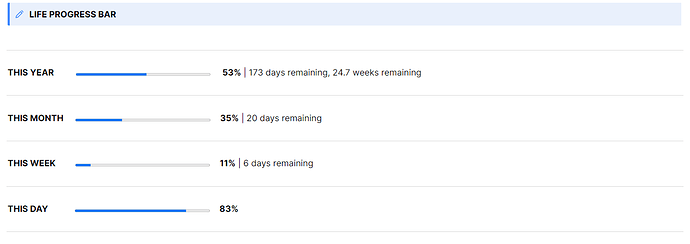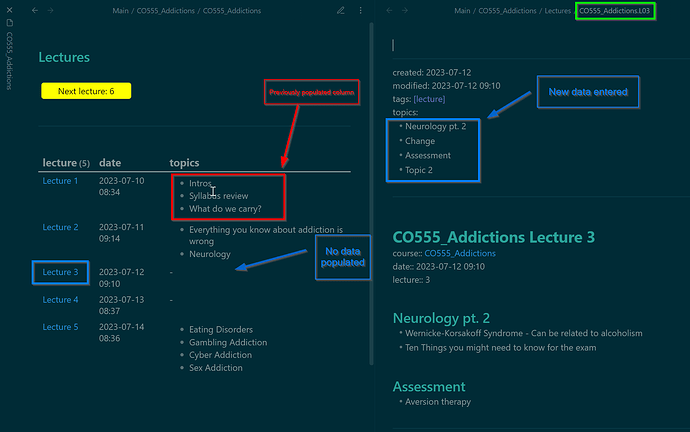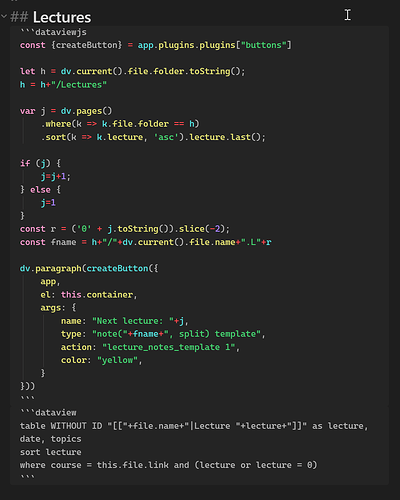updated with more details on Excalidraw and problems databse section
Expanding and implementing a relational database from my previous post, I have created some more nifty trinkets to automate some processes of taking lecture notes, and various other notes for a university student.
- Requirements: latest version of
- Dataview plugin
- Templater plugin
- Buttons plugin
Semester page
Progress-bar for the semester
- add the date of starting of semester in the first line and the ending of the semester in the second line

## Semester
```dataviewjs
var a = moment("2022-01-01");
var b = moment("2022-12-25");
var n = moment()
var t = moment().startOf('day');
let q = b.diff(a, 'days');
let p = b.diff(t, 'days');
let r = t.diff(a, 'days');
let h = n.diff(a, 'hours');
let i = b.diff(a, 'hours');
let html = `<progress style="height:10px;width:80%" value="`+h+`" max="`+i+`"></progress>`
if (r>0 && r<q) {
html += `\n#### `+p+` days left of `+q+` days\n`
html += (h/i*100).toFixed(2)+`% complete`
} else if (r==0) {
html += `\nstars today`
} else if (r==q) {
html += `\nends today`
} else if (r>q) {
html += `\nended `+-p+` days ago`
}else {
html += `\n#### `+-r+` days to go`
}
dv.paragraph(html)
```
gallery-type (css) courses query
I made this using the css snippet here: Obsidian Snippets - Dataview Table as Cards
Course pages
- Dynamically create lecture note number with proper numbering.
- The format for lecture note name is “OMD101.L01”
- The lecture note is created under a sub-folder “Lectures”, which needs to be created before hand
- Add the name template for lectures notes in this line:
action: "% lecture-note",in place of of% lecture-note. This template must be kept in the templates folder of Templater plugin, as Buttons plugin takes the template from there.
# OMD101
## Lectures
```dataviewjs
const {createButton} = app.plugins.plugins["buttons"]
let h = dv.current().file.folder.toString();
h = h+"/Lectures"
var j = dv.pages()
.where(k => k.file.folder == h)
.sort(k => k.lecture, 'asc').lecture.last();
if (j) {
j=j+1;
} else {
j=1
}
const r = ('0' + j.toString()).slice(-2);
const fname = h+"/"+dv.current().file.name+".L"+r
dv.paragraph(createButton({
app,
el: this.container,
args: {
name: "Next lecture: "+j,
type: "note("+fname+", split) template",
action: "% lecture-note",
color: "yellow",
}
}))
```
```dataview
table WITHOUT ID "[["+file.name+"|Lecture "+lecture+"]]" as lecture, date, topics, rec, coursenotes
sort lecture
where course = this.file.link and (lecture or lecture = 0)
```
Lecture notes
Why write in Obsidian
There are drawbacks to writing in Obsidian for taking notes in Mathematics, Physics and Chemistry. But still, taking notes in full-on latex is not for everyone, and definitely not same as taking them in Obsidian.
Obsidian gives the following benefits over making notes in LaTeX or handwriting them digitally completely and keeping them as PDFs:
- Obsidian notes and the entire vault is dynamic. Between lectures, one can directly link to previously written notes, to specific pages in documents in the vault, and one can embed them too! Live preview has made this even better!
- Obsidian notes are plaintext. That definitely has benefits over storing them as PDFs.
- Dataview queries can help create a dynamic table of lecture note details, anything you want to display. I used a parameter “topic” to list all topics discussed in the lecture.
- Excalidraw plugin is a highly active in development plugin to draw figures, flowcharts and also can be used to handwrite notes! (More about how to use this latter on in the post.)
Lecture notes template
- Takes in the name “OMD101.L01” and fills in the course as “OMD101” and lecture number as “1”
---
created: <% tp.file.creation_date("YYYY-MM-DDTHH:mm:ss") %>
modified: <% tp.file.last_modified_date("YYYY-MM-DDTHH:mm:ss") %>
tags: [lecture]
topics:
- <% tp.file.cursor(2) %>
---
<%*
let title = tp.file.title;
var course = title.slice(0,-4);
var lecture = title.slice(-2);
lecture = Number(lecture);
%>
# <%* tR += `${course}` %> Lecture <%* tR += `${lecture}` %>
- [i] course:: [[<%* tR += `${course}` %>]]
- [i] date:: <% tp.file.creation_date("YYYY-MM-DDTHH:mm:ss") %>
- [i] lecture:: <%* tR += `${lecture}` %>
- [i] rec::
# <% tp.file.cursor(1) %>
---
- [i] CourseNotes::
Making Excalidraw play nice
This is how mixing Excalidraw with general notes look for me:
- Quickly “create a new drawing and embed it and open it in a new pane” by setting this specific command into a hotkey.
- Create a Excalidraw drawing with transparent background and blank canvas. Set it as the Excalidraw template.
- For repetitive diagrams like aromatic rings in organic chemistry, coordinate axes, etc. you can add the ring and some common compounds into the Excalidraw library, from where you can bring them again and again.
- Increase the default width of the embedded drawing in excalidraw settings. I set it to 700, where my leaf width is 750 in Sliding panes plugin.
Problems database
Keeping a database of all cool problems one has solved would be a desirable habit. I made it using tags, and not hierarchical, divided up by semesters because that is how I wanted the database to be.
This is for querying the list of problems, and making a button to add a new problem. The Dataview query groups the problems by the tags in the note. Again add the template for problems in the line action: "% problem",
## *problems database*
```dataviewjs
const {createButton} = app.plugins.plugins["buttons"]
let h = dv.current().file.folder.toString();
dv.paragraph(createButton({
app,
el: this.container,
args: {
name: "New problem",
type: "note("+h+"/Untitled, split) template",
action: "% problem",
}
}))
```
```dataview
table rows.file.link as name
from #problem OR #Problem
group by file.tags
flatten file.tags
```
Problem template
- Asks for a title of the problem and creates a note with date as a prefix. This way we don’t have to be too specific in the note title and can have a short enough title.
- The input title is put in the
title:variable in the frontmatter which can be changed by adding the specifics if required. - Then it asks for the subject. This is added as a tag in the note like
#problem #math- My array contains:
- “math”
- “physics”
- “chemistry”
- “biology”
- “cs” - Computer Sciences
- “programming” - Computer Programming, coding
- “astronomy”
- "earth-sci - Earth Sciences
- My array contains:
---
created: <% tp.file.creation_date("YYYY-MM-DDTHH:mm:ss") %>
modified: <% tp.file.last_modified_date("YYYY-MM-DDTHH:mm:ss") %>
<%*
let title = tp.file.title;
const name = await tp.system.prompt("Problem Name");
if (name) {
title = "PROB."+tp.file.creation_date("YYYY-MM-DD-")+name
} else {
title = "PROB."+tp.file.creation_date("YYYY-MM-DD-HHmmss")
}
await tp.file.rename(title);
const sbjo = ["math", "physics", "chemistry", "biology", "cs", "programming", "astronomy", "earth-sci"];
const subject = await tp.system.suggester(sbjo, sbjo)
%>tags: [problem, <%* tR += `${subject}` %>]
title: <%* tR += `${name}` %>
alias: [<%* tR += `${name}` %>]
---
# <%* tR += `${name}` %>
<% tp.file.cursor() %>
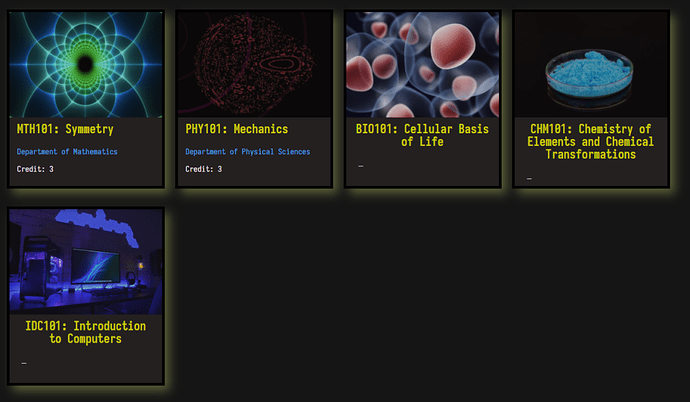

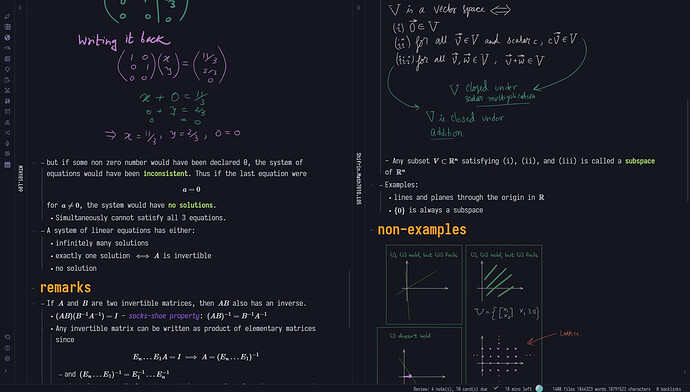
 I would recommend updating Dataview, Buttons, and Templater plugins.
I would recommend updating Dataview, Buttons, and Templater plugins.